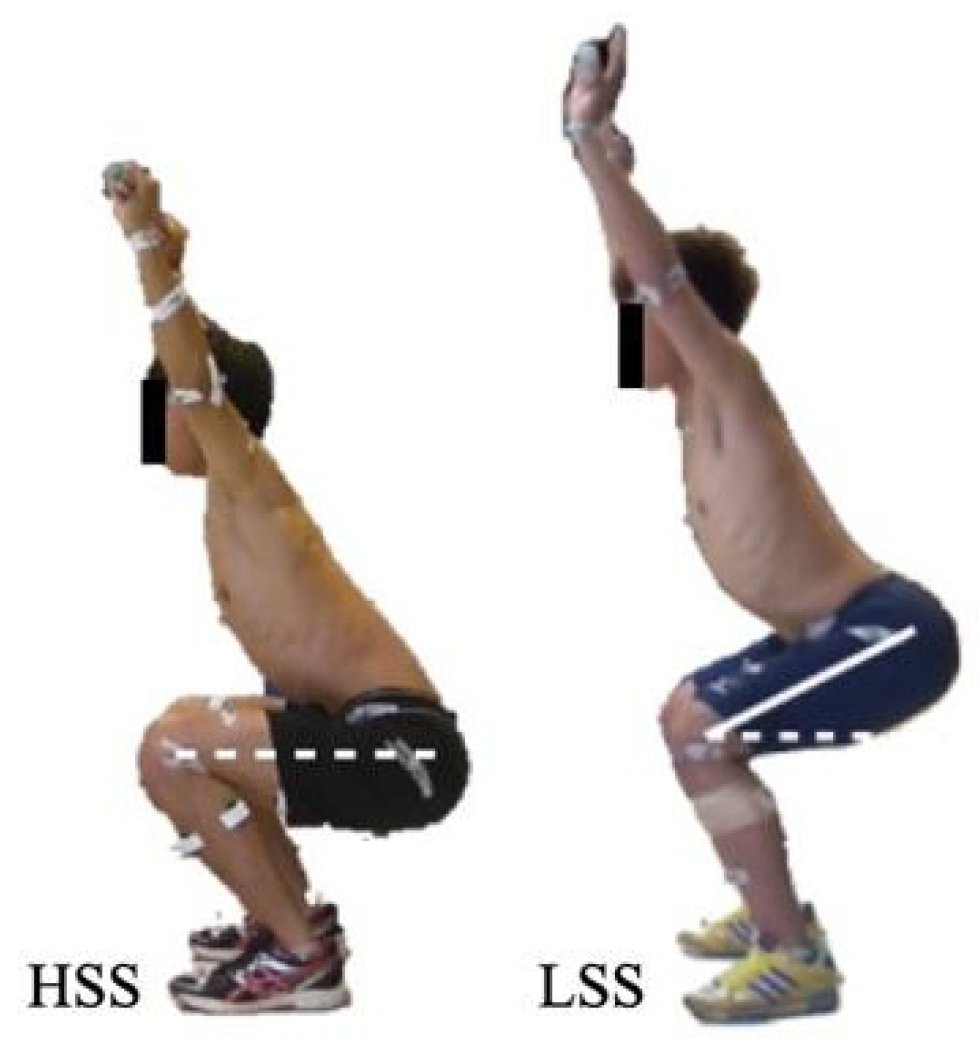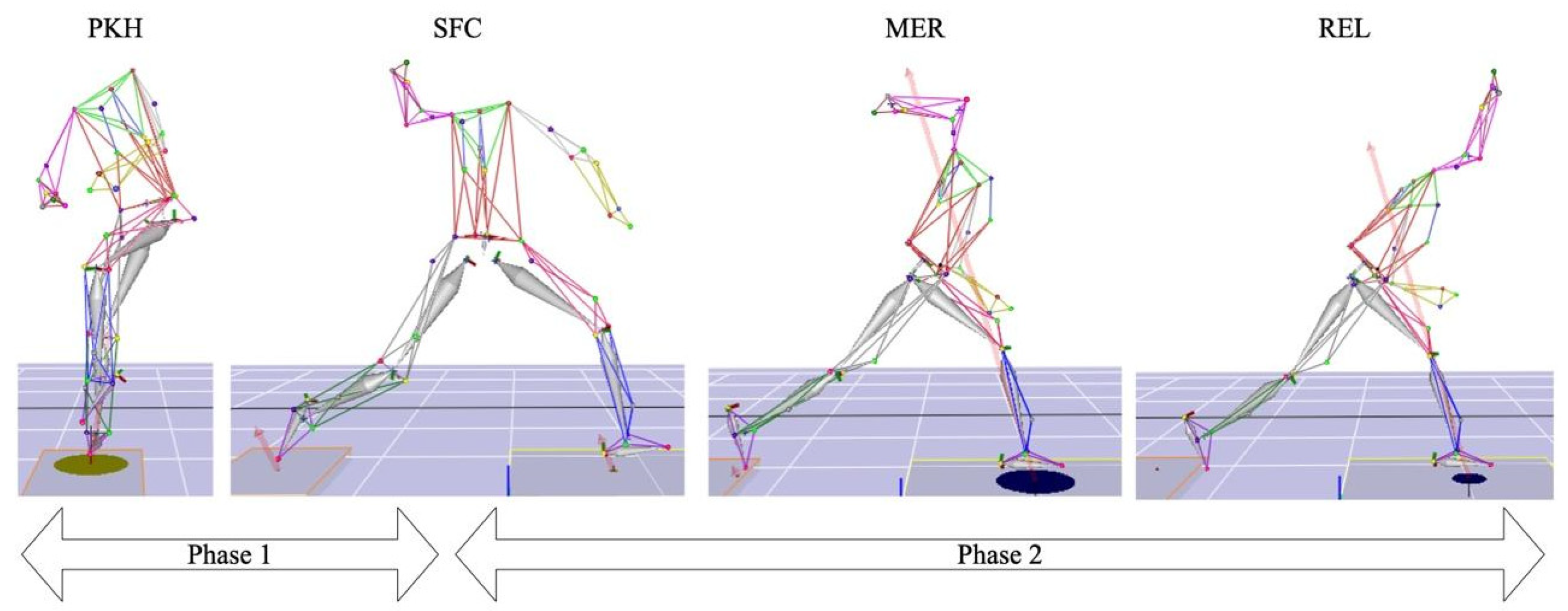Does Deep Squat Quality Affect the Propulsion of Baseball Throwing?
Abstract
:1. Introduction
2. Materials and Methods
2.1. Procedures
2.2. Data Analysis
2.3. Statistical Analyses
3. Results
4. Discussion
5. Conclusions
Author Contributions
Funding
Institutional Review Board Statement
Informed Consent Statement
Data Availability Statement
Acknowledgments
Conflicts of Interest
References
- Guido, J.A., Jr.; Werner, S.L. Lower-extremity ground reaction forces in collegiate baseball pitchers. J. Strength Cond. Res. 2012, 26, 1782–1785. [Google Scholar] [CrossRef]
- MacWilliams, B.A.; Choi, T.; Perezous, M.K.; Chao, E.Y.; McFarland, E.G. Characteristic ground-reaction forces in baseball pitching. Am. J. Sports Med. 1998, 26, 66–71. [Google Scholar] [CrossRef] [PubMed]
- Calabrese, G.J. Pitching mechanics, revisited. Int. J. Sports Phys. Ther. 2013, 8, 652–660. [Google Scholar] [PubMed]
- Ramsey, D.K.; Crotin, R.L. Stride length: The impact on propulsion and bracing ground reaction force in overhand throwing. Sports Biomech. 2019, 18, 553–570. [Google Scholar] [CrossRef] [PubMed]
- Chen, S.-W.; Tang, W.-T.; Kung, J.-T.; Hung, T.-Y.; Chen, Y.-L.; Lin, W.-H.; Burgee, D.J. Stride pattern of the lower extremities among stride types in baseball pitching. Front. Sports Act. Living 2021, 3, 670395. [Google Scholar] [CrossRef] [PubMed]
- Chen, J.Y.; Ho, J.S. The Mechanism of Baseball Pithing. Sports Res. Rev. 2009, 102, 131–137. [Google Scholar] [CrossRef]
- Lin, Y.-C.; Chou, P.P.-H.; Lin, H.-T.; Shih, C.-L.; Lu, C.-C.; Su, F.-C. A new method for evaluating pelvic and trunk rotational pitching mechanics: From qualitative to quantitative approaches. Int. J. Environ. Res. Public Health 2021, 18, 905. [Google Scholar] [CrossRef] [PubMed]
- Elliott, B.; Grove, J.R.; Gibson, B. Timing of the lower limb drive and throwing limb movement in baseball pitching. Int. J. Sport Biomech. 1988, 4, 59–67. [Google Scholar] [CrossRef]
- Kageyama, M.; Sugiyama, T.; Takai, Y.; Kanehisa, H.; Maeda, A. Kinematic and kinetic profiles of trunk and lower limbs during baseball pitching in collegiate pitchers. J. Sports Sci. Med. 2014, 13, 742. [Google Scholar]
- Liu, J.M.; Knowlton, C.; Gauthier, M.; Tropp, Z.; Verma, N.; Nicholson, G.; Romeo, A.; Zaferiou, A. Roles of each leg in impulse generation in professional baseball pitchers: Preliminary findings uncover the contribution of the back leg towards whole-body rotation. Sports Biomech. 2023, 1–16. [Google Scholar] [CrossRef]
- Chen, S.W.; Tang, W.T.; Hung, T.Y.; Kung, J.T.; Lin, W.H.; Chen, Y.L.; Burgee, D.J. The Comparison of Ground Reaction Force Among Stride Types in Baseball Pitching. Sports Biomech. 2024; in press. [Google Scholar]
- Howenstein, J.; Kipp, K.; Sabick, M.B. Energy flow analysis to investigate youth Pitching velocity and efficiency. Med. Sci. Sports Exerc. 2019, 51, 523–531. [Google Scholar] [CrossRef]
- Matsuo, T.; Escamilla, R.F.; Fleisig, G.S.; Barrentine, S.W.; Andrews, J.R. Comparison of kinematic and temporal parameters between different pitch velocity groups. J. Appl. Biomech. 2001, 17, 1–13. [Google Scholar] [CrossRef]
- Cook, G.; Burton, L.; Hoogenboom, B. Pre-participation screening: The use of fundamental movements as an assessment of function—Part 1. N. Am. J. Sports Phys. Ther. NAJSPT 2006, 1, 62–72. [Google Scholar]
- Butler, R.J.; Plisky, P.J.; Southers, C.; Scoma, C.; Kiesel, K.B. Biomechanical analysis of the different classifications of the Functional Movement Screen deep squat test. Sports Biomech. 2010, 9, 270–279. [Google Scholar] [CrossRef] [PubMed]
- Kiesel, K.; Plisky, P.J.; Butler, R.J. Functional movement test scores improve following a standardized off-season intervention program in professional football players. Scand. J. Med. Sci. Sports 2011, 21, 287–292. [Google Scholar] [CrossRef]
- Kiesel, K.; Plisky, P.J.; Voight, M.L. Can serious injury in professional football be predicted by a preseason functional movement screen? N. Am. J. Sports Phys. Ther. NAJSPT 2007, 2, 147. [Google Scholar]
- Cook, G.; Burton, L.; Hoogenboom, B. Pre-participation screening: The use of fundamental movements as an assessment of function—Part 2. N. Am. J. Sports Phys. Ther. NAJSPT 2006, 1, 132. [Google Scholar]
- Ebben, W.P.; Hintz, M.J.; Simenz, C.J. Strength and conditioning practices of Major League Baseball strength and conditioning coaches. J. Strength Cond. Res. 2005, 19, 538–546. [Google Scholar] [PubMed]
- Fleisig, G.S.; Barrentine, S.W.; Escamilla, R.F.; Andrews, J.R. Biomechanics of overhand throwing with implications for injuries. Sports Med. 1996, 21, 421–437. [Google Scholar] [CrossRef]
- Karadimitriou, S.M.; Marshall, E.; Knox, C. Mann-Whitney U Test; Sheffield Hallam University: Sheffield, UK, 2018; p. 4. [Google Scholar]
- Chapman, R.F.; Laymon, A.S.; Arnold, T. Functional movement scores and longitudinal performance outcomes in elite track and field athletes. Int. J. Sports Physiol. Perform. 2014, 9, 203–211. [Google Scholar] [CrossRef]
- Liang, Y.-P.; Kuo, Y.-L.; Hsu, H.-C.; Hsia, Y.-Y.; Hsu, Y.-W.; Tsai, Y.-J. Collegiate baseball players with more optimal functional movement patterns demonstrate better athletic performance in speed and agility. J. Sports Sci. 2019, 37, 544–552. [Google Scholar] [CrossRef]
- Lloyd, R.S.; Oliver, J.L.; Radnor, J.M.; Rhodes, B.C.; Faigenbaum, A.D.; Myer, G.D. Relationships between functional movement screen scores, maturation and physical performance in young soccer players. J. Sports Sci. 2015, 33, 11–19. [Google Scholar] [CrossRef] [PubMed]
- Laudner, K.; Lynall, R.; Williams, J.G.; Wong, R.; Onuki, T.; Meister, K. Thoracolumbar range of motion in baseball pitchers and position players. Int. J. Sports Phys. Ther. 2013, 8, 777. [Google Scholar] [PubMed]
- Heneghan, N.R.; Webb, K.; Mahoney, T.; Rushton, A. Thoracic spine mobility, an essential link in upper limb kinetic chains in athletes: A systematic review. Transl. Sports Med. 2019, 2, 301–315. [Google Scholar] [CrossRef]
- Sciascia, A.; Thigpen, C.; Namdari, S.; Baldwin, K. Kinetic chain abnormalities in the athletic shoulder. Sports Med. Arthrosc. Rev. 2012, 20, 16–21. [Google Scholar] [CrossRef] [PubMed]
- Crotin, R.L.; Kozlowski, K.; Horvath, P.; Ramsey, D.K. Altered stride length in response to increasing exertion among baseball pitchers. Med. Sci. Sports Exerc. 2014, 46, 565–571. [Google Scholar] [CrossRef]
- Burkhart, S.S.; Morgan, C.D.; Kibler, W.B. The disabled throwing shoulder: Spectrum of pathology Part I: Pathoanatomy and biomechanics. Arthrosc. J. Arthrosc. Relat. Surg. 2003, 19, 404–420. [Google Scholar] [CrossRef]
- Tripp, B.L.; Yochem, E.M.; Uhl, T.L. Functional fatigue and upper extremity sensorimotor system acuity in baseball athletes. J. Athl. Train. 2007, 42, 90. [Google Scholar]


| Valuables | HSS (N = 13) Mean ± SD | LSS (N = 9) Mean ± SD | p | ES |
|---|---|---|---|---|
| Pivot leg | ||||
| Peak Fx (%BW) | 44.82 ± 11.53 | 41.73 ± 9.55 | 0.526 | 0.14 |
| Peak Fz (%BW) | 119.58 ± 8.78 | 121.56 ± 11.92 | 0.764 | 0.06 |
| Velocity/Peak Fx (m/s/N) | 0.71 ± 0.15 | 0.73 ± 0.11 | 0.764 | 0.06 |
| Velocity/Peak Fz (m/s/N) | 0.26 ± 0.03 | 0.24 ± 0.02 | 0.243 | 0.25 |
| Leading leg | ||||
| Peak Fx (%BW) | −65.57 ± 12.61 | −67.38 ± 10.93 | 0.570 | 0.12 |
| Peak Fz (%BW) | 158.81 ± 20.33 | 188.47 ± 35.51 | 0.030 * | 0.46 |
| Velocity/Peak Fx (m/s/N) | −0.48 ± 0.08 | −0.45 ± 0.06 | 0.271 | 0.23 |
| Velocity/Peak Fz (m/s/N) | 0.19 ± 0.02 | 0.16 ± 0.02 | 0.002 * | 0.66 |
| Time | HSS (N = 13) Mean ± SD | LSS (N = 9) Mean ± SD | p | ES |
|---|---|---|---|---|
| Pivot leg | ||||
| Time to Peak Fx (% of Throw) | 87.08 ± 11.17 | 84.44 ± 14.18 | 0.570 | 0.12 |
| Time to Peak Fz (% of Throw) | 61.53 ± 20.36 | 55.79 ± 16.10 | 0.443 | 0.16 |
| Leading leg | ||||
| Time to Peak Fx (% of Throw) | 72.37 ± 14.61 | 71.79 ± 11.29 | 0.920 | 0.02 |
| Time to Peak Fz (% of Throw) | 81.81 ± 13.01 | 80.55 ± 7.51 | 0.973 | 0.01 |
| Variables | HSS (N = 13) Mean ± SD | LSS (N = 9) Mean ± SD | p | ES |
|---|---|---|---|---|
| Ball Velocity (m/s) | 30.64 ± 3.33 | 29.56 ± 2.60 | 0.349 | 0.20 |
| Pivot leg | ||||
| ImpulseFresultant (N s) | 54.50 ± 11.25 | 73.82 ± 22.60 | 0.035 * | 0.45 |
| ImpulseFx (N s) | 14.02 ± 3.08 | 16.61 ± 4.51 | 0.049 * | 0.42 |
| ImpulseFz (N s) | 52.58 ± 11.21 | 71.75 ± 22.67 | 0.048 * | 0.42 |
| Velocity/ImpulseFresultant (m/s/N) | 0.60 ± 0.19 | 0.43 ± 0.12 | 0.035 * | 0.45 |
| Velocity/Impulse Fx (m/s/N) | 2.26 ± 0.48 | 1.86 ± 0.33 | 0.053 | 0.41 |
| Velocity/Impulse Fz (m/s/N) | 0.62 ± 0.21 | 0.45 ± 0.13 | 0.032 * | 0.46 |
| Leading leg | ||||
| ImpulseFresultant (N s) | 20.39 ± 5.04 | 31.27 ± 7.94 | 0.001 * | 0.69 |
| Impulse Fx (N s) | −7.76 ± 1.70 | −11.37 ± 3.67 | 0.007 * | 0.58 |
| Impulse Fz (N s) | 18.78 ± 4.83 | 29.04 ± 7.16 | 0.001 * | 0.70 |
| Velocity/ImpulseFresultant (m/s/N) | 1.64 ± 0.63 | 0.99 ± 0.21 | 0.003 * | 0.63 |
| Velocity/Impulse Fx (m/s/N) | −4.23 ± 1.45 | −2.81 ± 0.77 | 0.005 * | 0.60 |
| Velocity/Impulse Fz (m/s/N) | 1.79 ± 0.70 | 1.06 ± 0.23 | 0.021 * | 0.49 |
| Angle (deg) | HSS (N = 13) Mean ± SD | LSS (N = 9) Mean ± SD | p | ES | |
|---|---|---|---|---|---|
| Hip Flexion | Maximum | 153.17 ± 12.18 | 157.48 ± 11.75 | 0.483 | 0.15 |
| Minimum | 124.05 ± 13.95 | 120.50 ± 10.40 | 0.616 | 0.11 | |
| Displacement | 29.12 ± 6.02 | 36.97 ± 13.74 | 0.217 | 0.26 | |
| Knee Extension | Maximum | 173.59 ± 9.00 | 174.20 ± 6.17 | 0.973 | 0.01 |
| Minimum | 128.15 ± 13.47 | 126.59 ± 15.07 | 0.815 | 0.05 | |
| Displacement | 45.44 ± 13.62 | 47.60 ± 15.24 | 0.815 | 0.05 | |
| Ankle Dorsiflexion | Maximum | 118.53 ± 6.78 | 116.45 ± 6.71 | 0.404 | 0.18 |
| Minimum | 100.12 ± 6.27 | 96.94 ± 4.23 | 0.102 | 0.35 | |
| Displacement | 18.41 ± 4.65 | 19.51 ± 5.29 | 0.616 | 0.11 |
Disclaimer/Publisher’s Note: The statements, opinions and data contained in all publications are solely those of the individual author(s) and contributor(s) and not of MDPI and/or the editor(s). MDPI and/or the editor(s) disclaim responsibility for any injury to people or property resulting from any ideas, methods, instructions or products referred to in the content. |
© 2024 by the authors. Licensee MDPI, Basel, Switzerland. This article is an open access article distributed under the terms and conditions of the Creative Commons Attribution (CC BY) license (https://creativecommons.org/licenses/by/4.0/).
Share and Cite
Lin, W.-H.; Huang, T.-Y.; Chen, S.-W.; Hamill, J.; Kung, J.-T.; Tang, W.-T. Does Deep Squat Quality Affect the Propulsion of Baseball Throwing? Bioengineering 2024, 11, 248. https://doi.org/10.3390/bioengineering11030248
Lin W-H, Huang T-Y, Chen S-W, Hamill J, Kung J-T, Tang W-T. Does Deep Squat Quality Affect the Propulsion of Baseball Throwing? Bioengineering. 2024; 11(3):248. https://doi.org/10.3390/bioengineering11030248
Chicago/Turabian StyleLin, Wei-Hsuan, Tsung-Yu Huang, Shu-Wei Chen, Joseph Hamill, Jung-Tang Kung, and Wen-Tzu Tang. 2024. "Does Deep Squat Quality Affect the Propulsion of Baseball Throwing?" Bioengineering 11, no. 3: 248. https://doi.org/10.3390/bioengineering11030248







